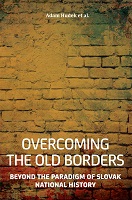“A Home Should Be a Home to All Its Sons”: Cultural Representations of Saint Stephen in Slovakia during the Interwar Period
“A Home Should Be a Home to All Its Sons”: Cultural Representations of Saint Stephen in Slovakia during the Interwar Period
Author(s): Miroslav Michela
Subject(s): Christian Theology and Religion, Cultural history, Interwar Period (1920 - 1939)
Published by: SAV - Slovenská akadémia vied - Historický ústav SAV
Keywords: Saint Stephen; Interwar Period; Slovakia;
Summary/Abstract: In August 2009 the waters of European politics and especially the Slovak-Hungarian diplomatic relations, were stirred up by an event linked with the unveiling of the equestrian statue of Saint Stephen in the Slovak border town, Komárno. The President of the Republic of Hungary, László Sólyom, who had been invited as a keynote speaker for this event, was not admitted to enter the Slovak Republic (SR). Although the resulting conflict originated mainly from already tense political relations, as has happened in other cases, events did not go without a historicist interpretation. The Prime Minister of the Slovak Republic, Robert Fico, reproduced the standard representation of Saint Stephen as the symbol of national oppression, when he commented that: “Under the Flag of the First Hungarian King Stephen the harshest magyarization occurred. Therefore let no one pretend that he was some sort of Slovak king. We have our own Svätopluk, not Stephen.” By contrast, the organisers of the statue’s unveiling were interpreting Saint Stephan as a symbol of cooperation and ethnical intertolerance. As the Mayor of Komárno, Tibor Bastrnák, pointed out “Saint Stephen founded and built a strong state of many nations where people lived with each other in peace.” However, they were criticised by the representatives of Slovakia that they had not shown enough interest and activities towards ensuring the parity participation of politicians, as it is usually the case in official state visits. In a pro-government periodical, the present day’s President of Matica slovenská, Marián Tkáč, called this act a demonstration of “Hungarian arrogance and superiority. And pride.” In the subsequent, often emotionally charged, discussions that followed, several conflicting narratives appeared concerning the importance of the ϐirst Hungarian monarch and saint of the Árpád family. At the same time, Stephen became a symbol of both “ethnic tolerance” and “national oppression”. The diplomatic incident in mentioned and, in particular, mentions of Saint Stephen also draw attention to the importance of historical narratives in public discourse.
Book: Overcoming the Old Borders. Beyond the Paradigm of Slovak National History
- Page Range: 97-110
- Page Count: 14
- Publication Year: 2013
- Language: English
- Content File-PDF

